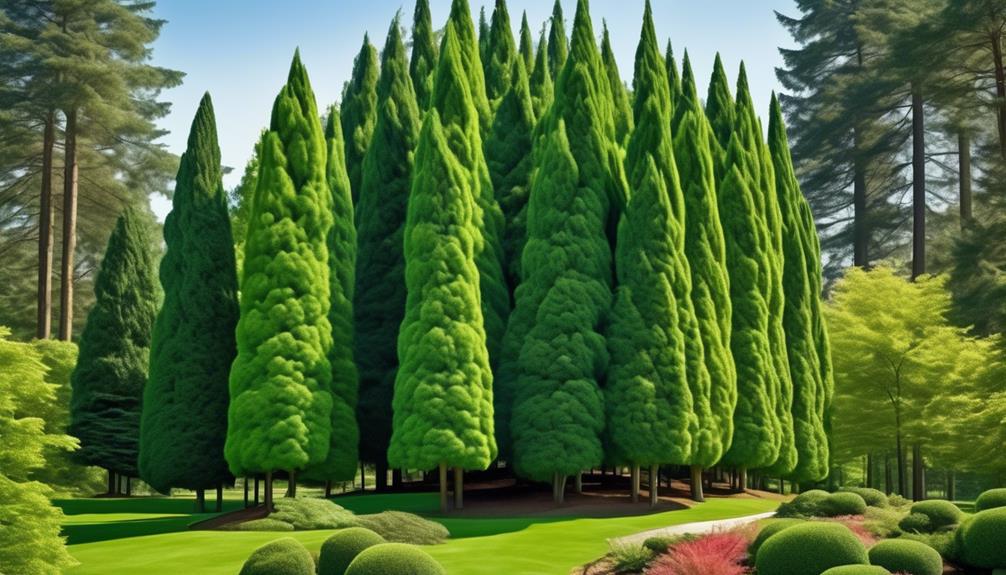They say that ‘a tree is known by its fruit.’ Well, in the case of arborvitae, it’s more like ‘a tree is known by its versatility.’
Arborvitae, also known as the Tree of Life, has been a trusted companion to humankind for centuries, providing both practical and aesthetic benefits.
But what makes this tree so special? How has it earned its noble title as Nature’s Sentinel?
The answers lie within its ecological significance, intriguing origins, and cultural importance.
So, gather around and prepare to uncover the fascinating tale of arborvitae, a tree that holds the key to both our past and our future.
Arborvitae’s Ecological Importance
Arborvitae plays a vital role in maintaining ecological balance and biodiversity. As a native evergreen tree, it serves as nature’s sentinel, standing tall and strong to protect and support the surrounding ecosystem. With its dense foliage and rapid growth, Arborvitae provides a crucial habitat and cover for various wildlife species.
It acts as a sanctuary, attracting birds and other animals, contributing to the overall biodiversity of the area. Moreover, Arborvitae serves as a living privacy screen, blocking unwanted views and creating a sense of tranquility in both residential and commercial settings.
Its ecological importance can’t be overstated, as it not only enhances the beauty of the landscape but also provides a sanctuary for countless living organisms, making it truly the tree of life.
Story and Origins
The captivating tale of Arborvitae’s origins and journey begins with its introduction to Europe as the first North American tree, earning it the moniker ‘tree of life.’ Native to North America, Arborvitae belongs to the arborvitae species and is part of the cypress family. Its remarkable beauty and functionality have made it a popular choice for landscaping. The tree’s dense growth and fast-growing nature make it an excellent natural privacy screen. Its durability and resistance to pests and diseases ensure its longevity, while its vibrant green foliage adds timeless elegance to any landscape. Arborvitae’s versatility is exemplified by the Green Giant Arborvitae, a popular variety known for its rapid growth and ability to create windbreaks and hedges. This tree has truly become nature’s sentinel, providing both beauty and practicality in equal measure.
| Key Points | |
|---|---|
| Common Name | Arborvitae |
| Scientific Name | Thuja |
| Family | Cypress |
| Origin | North America |
Significance of Arborvitae’s Name
As we continue our exploration of Arborvitae, let’s now uncover the significance behind its name, shedding light on its historical and cultural associations.
The name ‘arborvitae’ comes from the Latin form of the French ‘larbre de vie,’ meaning tree of life. This name reflects the tree’s historical use by early Indians and French explorers for its medicinal properties. In fact, tea made from the bark and leaves of the arborvitae treated scurvy in the 16th century.
Arborvitae is also known as nature’s sentinel and the tree of life, as it was the first North American tree to be introduced to Europe. With its excellent root system and visual interest, the arborvitae, especially the Green Giant (Thuja standishii x plicata), is often used as focal points in gardens and landscapes. Its emerald green foliage holds a special place in the hearts of many, making it one of the most cherished ornamental tree species.
It’s ideal for withstanding cold winters and drought, making it an excellent addition to any landscape.
Cultural Significance
With its rich history intertwined with human civilization, arborvitae holds significant cultural importance.
This tall, evergreen tree has been a favorite among different cultures for centuries. Its vibrant green foliage adds beauty to landscapes and has practical applications in privacy screens, foundation plantings, and ornamental landscaping.
Arborvitae’s rapid growth and ability to thrive in full sun make it a popular choice for creating natural barriers and windbreaks. Its name, derived from the French term ‘larbre de vie,’ further emphasizes its symbolic value as the tree of life.
Early Indians and French explorers recognized its medicinal properties, adding to its cultural significance.
Today, arborvitae continues to be cherished for its beauty, resilience, and the sense of serenity it brings to any environment.
Caring for Arborvitae Pruning
To ensure the health and growth of your arborvitae, proper pruning techniques are crucial. Pruning dead branches is essential as it promotes new growth and improves the tree’s shape and appearance.
Arborvitae, with its graceful form and hardy nature, is often used in landscapes to add visual interest. It can withstand drought conditions and has a fast growth rate of up to three feet per year. Regular watering is necessary to maintain its health and vigor.
When pruning, be cautious to avoid skin irritation caused by sap exposure. If you have specific concerns about pruning, it’s recommended to consult a certified arborist who can provide expert guidance based on factors such as nutrients, sunlight, moisture, and the tree’s age.
Best Occasions to Gift Arborvitae
Looking for the perfect gift for a special occasion? Consider gifting an arborvitae tree, a symbol of growth and strength, to celebrate and commemorate significant milestones.
Arborvitae, with its dense foliage and evergreen foliage, is a fantastic choice for outdoor spaces. It can be planted in a range of soils and requires minimal maintenance, making it ideal for garden enthusiasts of all levels.
Whether it’s a housewarming, wedding, birthday, anniversary, or a new beginning, arborvitae is a meaningful gift that will bring a sense of natural beauty to any landscape. Its needle-like leaves and ability to withstand drought make it a resilient tree that can thrive in various conditions.
Concluding Thought
As you consider gifting an arborvitae tree for those special occasions, remember that this timeless and elegant plant won’t only bring natural beauty to any landscape but also add a touch of resilience and strength.
Arborvitae, also known as nature’s sentinel and the tree of life, can grow up to 60 feet tall and has a dense, dark green foliage that remains vibrant year-round. Its upright growth habit makes it perfect for privacy screens when planted in rows.
Furthermore, arborvitae is known for its resistance to pests and diseases, making it a low-maintenance option for your garden.
Frequently Asked Questions
Why Is Arborvitae Called the Tree of Life?
Arborvitae is called the tree of life because of its medicinal properties and historical use in treating scurvy. Early Indians and French explorers recognized its healing abilities, leading to its association with the concept of life.
What Is the Downside of Arborvitae?
The downside of arborvitae is that it attracts bagworms, needs protection from deer, and can be vulnerable to windthrow. Fire protection may also be necessary, and brown spots indicate the need for fertilization and watering.
What Is the Spiritual Meaning of the Arborvitae Tree?
The spiritual meaning of the arborvitae tree is rooted in resilience, stability, and a connection to the divine. It symbolizes trust in God, perseverance, and inner strength, reflecting growth and spiritual development.
What Are the Healing Properties of Arborvitae?
Arborvitae heals and protects. Its oil, used in medicine, stimulates your immune system, like a shield against illness. Just as the tree attracts birds for cover, it attracts healing properties for your well-being.





